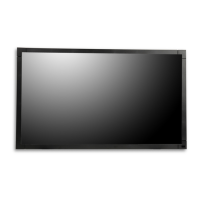31
Display Wall
• Press the ENTER button to display the sub-menu:
• H Monitors: Selects the number of displays used in the horizontal position. Press or to
change the setting.
• V Monitors: Selects the number of displays used in the vertical position. Press or to
change the setting.
• H Position: Selects the horizontal position of the monitor in the display wall matrix. Press the
or button to change selection.
• V Position: Selects the vertical position of the monitor in the display wall matrix. Press the or
button to change selection.
• Frame Comp.: Adjusts images near the display edges for optimal demonstration across the
display wall.
Power save
• If turned on, the LCD monitor will go to power management mode when PC sync is lost, and will enter
power management mode when no DVD/HD or VIDEO input signal can be detected three times in a
row.
• Press ENTER, and then press the or to select ON, OFF or VGA only.
Set Monitor ID
• By connecting multiple LCD monitors to a PC using RS-232C cables, you can control any one monitor
or all the monitors on the PC. Assign arbitrary ID number to each of multi-connected CDP6530
monitors using this function. ID numbers 1 to 99 are selectable. It is recommended to assign
sequential ID numbers from 1 and up.
• Press ENTER, and then the or button to change the ID number.
Image Retention
• If turned on, the LCD monitor automatically displays swift moving patterns to prevent the formation of
image retention on the screen.
• Press ENTER, and then the or button to turn this function on or off.
NOTE: IMAGE PERSISTENCE
• Please be aware that LCD Technology may experience a phenomenon known as Image Persistence.
Image Persistence occurs when residual or “ghost” image of a previous image remains visible on the
screen. Unlike CRT monitors, LCD monitors’ image persistence is not permanent, but constant
images being displayed for a long period of time should be avoided.
• To alleviate image persistence, turn off the monitor for as long as the previous image was displayed.
For example, if an image was on the monitor for one hour and a residual image remains, the monitor
should be turned off for one hour to erase the image.
• As with all personal display devices, ViewSonic recommends displaying moving images and using a
moving screen saver at regular intervals whenever the screen is idle or turning off the monitor when
not in use. Please use the Power Save and Schedule functions to further reduce the risk of image
persistence.
Auto Adjustment
• Turns on or off the Auto Adjustment function. Once turned on, the LCD monitor will automatically
optimize the image by adjusting the vertical position, horizontal position, clock frequency and phase
when the input signal timing is changed.
